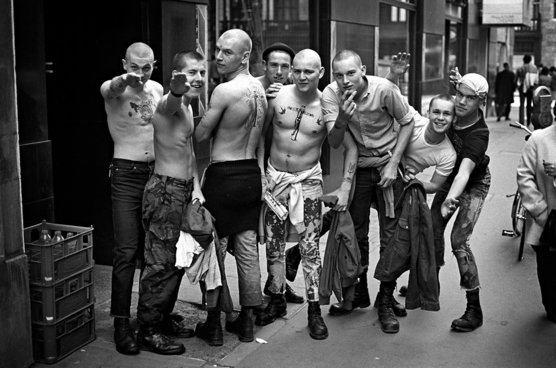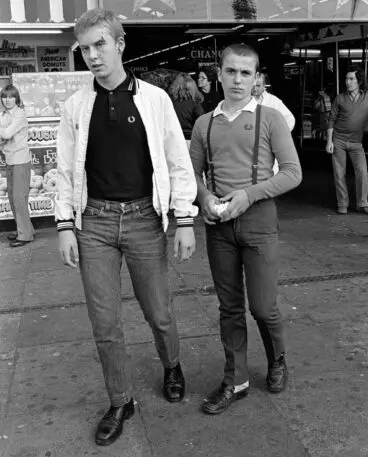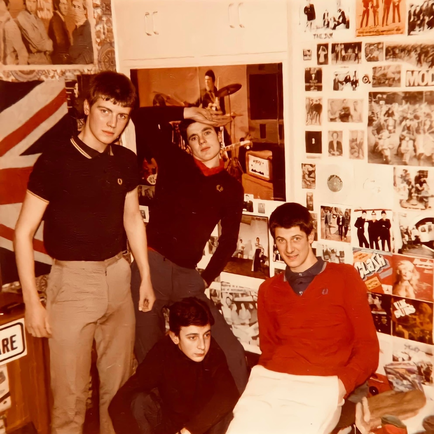FASHION ORIGIN
The story of the Skinhead movement can be told through their clothing, a gradually shifting look that reflects the influence of the subculture. In stark contrast to the ostentatious fashion of the latter half of the 1960s, working class pride was fabricated through a tough-yet-smart combination. Jeans, braces and heavy workwear, importantly, a short hairstyle. The movement always had a ‘threatening’ overtone, rejecting the youthful counter-culture movement that promoted an ideology of peace and love. Until the Right Wing faction infiltrated and perveted the original ethos, violence however, was never the consuming passion.
INTRODUCTION
1980s Britain was convulsed by a social and political revolution, the Skinhead movement attributes this to the Nationalist ideology that swept the subculture. Born from the fusion of the cross-pollination between the white working class and Caribbean immigrants, the Skinhead movement originated in the working-class neighbourhoods of London. The youth culture was characterised by hostile hair and dress style, tightly shaved heads and combat boots. During the period of mass immigration and unemployment within the United Kingdom there was a rise of nationalism within a sub-section of the Skinhead movement. Far right groups recruited white Skinheads, their image/movement quickly became equated with racism. The ‘aggressive’ uniform, previously credited to their working class background, transformed into a symbol of violence.
POLITICAL INFLUENCE
The first Skinheads were non-political. However, affronted with economic upheaval and social tensions that defined the 1980s, many were soon drawn into extreme Nationalism, especially anti-immigration groups. Far-right organisations harnessed the power of the Skinhead image, some were recruited by Neo-Nazi organisations, the movement became increasingly politicised. Demonstrating their fierce patriotism through the participation in right wing marches and rallies, they became ‘social pariahs.’ Racism was expressed through music, fashion and street violence. All Skinheads were tarnished as mindless, violent and racist. As the media failed to differentiation the divide in the subculture, the outfit was a threat in-itself.
WORKING CLASS
The media held a huge influence in the portrayal of the Skinhead movement, everyone who wore a Fred Perry shirt was a fascist and Dr.Martens a Nazi. The most common image that come to mind when thinking about a skinhead are people associated with racism, Neon-Nazism and fascism. However, some skinheads do not espouse any specific ideology, and others hold staunchly anti-racist and anti-fascist views. Whilst some Neo-Nationalist skins adorned clothing and even bodies with swastikas, the ‘uniform’ wasn’t born from politics. Originally a symbol of the working class, through the lens of the media, the fashion was affiliated with violence. Whilst the skin-shave has been closely associated with the racist groups, for the early adopters, the decision to shave their head was a matter of practicality. Many go the movement’s progenitors were blue-collar workers, in factories long hair was hot, heavy and dangerous. The ‘utilitarian’ fashion reflected a sense of pride in their working-class roots. The violent sub-sector of the movement stigmatised Skinhead fashion and defamed clothing brands they were affiliated with. Brands were politicised by Neon-Nazis wearing their clothes. This includes Brutus, Fred Perry, and Ben Sherman. Sullied by far-right association, said brands have since implemented strategies to change their image.
FRED PERRY
Fred Perry is a symbol of the British subculture, Skinheads. The movement, specifically the Nationalist subgroup, opted for a Fred Perry polo shirt as the non-conformist uniform. The style was appropriated by right wing Nationalists, turning the polo into a symbol of racism and bigotry. The British label, recognised for its preppy streetwear, was founded by Fred Perry in 1952. Perry, the son of a working class-socialist member of Parliament, was a Wimbledon Champion at a time where tennis was an elitist sport. What inspired Perry also inspired a generation of tennis players, and then rebels. When worn by working class youth, the Fred Perry Laurel served as a subversive commentary on English elitism. The brand rocketed in multicultural areas in London, embraced by the Skinhead movement, who promoted solidarity and pride in such neighbourhoods. The Skinhead culture spread to North-England, bringing the Fred Perry polo, that amounted popularity amongst football fans. At the time the Nationalist front party recruited members outside of football stadiums, a synergy between the Fred Perry Laurel and the fascists was born. The more ostracised and feared the sub-group were, the stronger their identity became. The struggle to distance itself from Nationalist continues, the brand continues to be adopted by those who spouse far-right rhetoric, ‘Proud Boys.’ 2017, Unite Rally, white suprematists and Neo-Nazis wore Fred Perry polos and gathered to unify the movement. Connecting with the social anger of the 1980s, the ‘Proud Boys,’ instead of wearing aggressive Skinhead gear, displayed the Fred Perry Laurel. The brand logo, based on the original icon for Wimbledon Tennis, stands as an ancient symbol for victory. For the Proud Boys, who wear the Fred Perry polo in attempt to normalise hate, triumph is white supremacy. Discontinuing certain Polo colour schemes and condemning the ideals, the brand has been forced to continue to deny involvement with the group. The powerful Skinhead aesthetic has scorned the brands intended image. The connotations the culture has with the far right movement made the motif a threat. The association of the Fred Perry polo with deviant groups has reduced the brand to the representations of hate and separation, impacted sales and the brand image with the intended customers.
DR MARTEN
Any form of youth expression has a uniform, the Skinheads adopted the ‘timeless classic’ Dr Marten boot, proudly championing working-class style. As racism and aggression seeped into the subculture, the shoe was seen as a symbol of rebellion. The vintage style leather and chunky rubber soles were subbed as ‘armour for the feet.’ 1945, German Nazi solider, Dr Klaus Maertens designed the shoe following a broken foot. Using military supplies to create the boot, the support and practicality aided Maertens’ recovery. Throughout the 1960s and 70s, the boots were associated with postal workers, police officers and were claimed as ‘street style’ by subcultures. The anti-fashion statement was adopted by the Skinheads and modified accordingly. It is necessary to emphasis not all Skinheads were racist or violent, that was a portrayal spread by the British media. Nevertheless, with Dr. Martens boots quintessential to the aggressive image, there was a sense the brand stood for those particular problematic attitudes. The shoe was so closely intertwined with the Skinheads, a culture undermined by extremists, during the 1980s, school children weren’t allowed to wear them to school because of their affiliation with violence. At football matches fans opted to change the laces based on team colours until they were requested to removal boots before entry. The toe caps on the shoes were weapons and would maximise damage upon another if an altercation broke out. The Dr. Martens boots, specifically the cherry red colour, were worn by Skinheads to reinforce their working class image. As the shoe became connected to the violence of the new element of Skinhead culture a new discourse was created. The Dr. Marten boot would undergo a ‘rite of passage’ when worn for a beating. The media, reflecting on the incident, would then proceed to name the brand of the shoe involved in the kicking. The Dr. Marten shoe was the weapon of choice and the Skinheads the army. Since, the brand has carefully curated an identity that emphasis it’s origin in multi-cultural, ‘ska’ (Jamaican fast pop music popular in the late 1950s) loving Skinheads, rather than the racist sub-group that tyrannised the movement. Communicating this version of events isn’t to manipulate customers but to associate the shoe with the working class resilience, a consideration which wasn't granted by the media to the Skinhead culture.
CONCLUSION
The skinhead community’s primary identity was personal style. The change in the discourse of the movement altered how the image was perceived. Skinhead fashion always possessed the ability to turn heads and draw attention. With the British media generalising the culture, all members were branded as racially motivated right-wing supporters. An image so tightly intertwined with identity, anyone dressed in Skinhead fashion was automatically deemed a threat. Clothes are symbolic, used as weapon by the culture both physically and psychologically. The far right sector within the Skinhead movement didn’t alter the fashion, it transformed how it was viewed through the aggressive connotation. To this day the hostile image is adopted by certain organisations to subtly project their alliance with the guiding beliefs of the far-right movement.
SOURCE
- Irpino, Louise. “A History of Fashion’s Most Iconic Combat Boots: Dr. Martens.” ArtRKL, artrkl.com/blogs/news/a-history-of-fashions-most-iconic-combat-boots-dr-martens. Accessed 12 May 2024.
- “Skinheads: A Photogenic, Extremist Corner of British Youth Culture.” The Guardian, Guardian News and Media, 19 Aug. 2014, www.theguardian.com/artanddesign/2014/aug/19/skinheads-derek-ridgers-portraits-street-photography-70s-80s-youth-culture.
- Team, BRICKS. “The Hypocrisy of the Skinhead: Fashion, Fascism, and Cultural Appropriation - Bricks Magazine.” BRICKS Magazine - If You Have a Voice, Use It., 6 Nov. 2020, bricksmagazine.co.uk/2020/11/06/the-hypocrisy-of-the-skinhead-fashion-fascism-and-cultural-appropriation/.
- “Battle of the Brands – DW – 02/16/2010.” Dw.Com, Deutsche Welle, 16 Feb. 2010, www.dw.com/en/fashion-labels-worn-by-europes-skinheads-restore-their-reputation/a-5226933.
- “The Brand.” Fred Perry UK, www.fredperry.com/brandbook. Accessed 12 May 2024.
- “Fashion ... or Fascist? The Long Tussle over That Fred Perry Logo.” The Guardian, Guardian News and Media, 4 Oct. 2020, www.theguardian.com/fashion/2020/oct/04/fashion-or-fascist-the-long-tussle-over-that-fred-perry-logo.
- Irpino, Louise. “A History of Fashion’s Most Iconic Combat Boots: Dr. Martens.” ArtRKL, artrkl.com/blogs/news/a-history-of-fashions-most-iconic-combat-boots-dr-martens. Accessed 12 May 2024.










